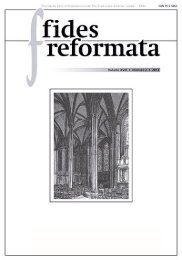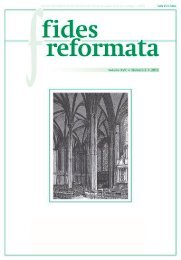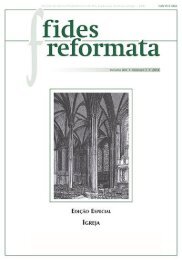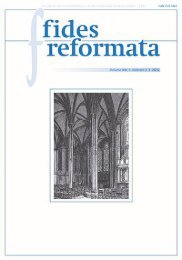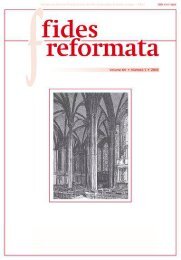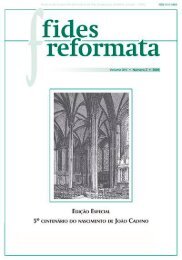Create successful ePaper yourself
Turn your PDF publications into a flip-book with our unique Google optimized e-Paper software.
P.H.R. (Rob) van Houwelingen, John and the Others<br />
2. “we” in the epilogue of the fourth gospel<br />
John 21:24-25<br />
Οὗτός ἐστιν ὁ μαθητὴς ὁ μαρτυρῶν περὶ τούτων καὶ ὁ γράψας ταῦτα, καὶ<br />
οἴδαμεν ὅτι ἀληθὴς αὐτοῦ ἡ μαρτυρία ἐστίν. Ἔστιν δὲ καὶ ἄλλα πολλὰ<br />
ἃ ἐποίησεν ὁ Ἰησοῦς, ἅτινα ἐὰν γράφηται καθ’ ἕν, οὐδ’ αὐτὸν οἶμαι τὸν<br />
κόσμον χωρῆσαι τὰ γραφόμενα βιβλία.<br />
This is the disciple who bears testimony to these facts and wrote these<br />
things; and we know that his testimony is trustworthy. There are also<br />
many other things which Jesus did. I suppose that if they were written<br />
<strong>do</strong>wn one by one, the world would be too small to contain the books that<br />
would have to be written.<br />
2.1 Chapter 21 as a whole<br />
A common view is that chapter 21 was originally not part of the Fourth<br />
Gospel. Consequently, there would have been no direct relation between the<br />
witness of the prologue and that of the epilogue. It is necessary, therefore, that<br />
we deal with a preliminary question: How <strong>do</strong>es chapter 21 relate to the rest of<br />
John’s Gospel? Three options are possible:<br />
1. Chapter 20:30-31 is the conclusion of John’s Gospel; chapter 21 is a<br />
later addition;<br />
2. Chapter 21 belongs to the whole of John’s Gospel;<br />
3. Only the verses 24-25 are a later addition.<br />
Option 3, although generally accepted today and in itself grammatically<br />
possible because the verses 24-25 are two independent clauses, may be ruled<br />
out for the following reasons. In the first place we should take note that the<br />
comment of the evangelist already starts in verse 23. Οὗτός points back<br />
to the beloved disciple mentioned there; it <strong>do</strong>es not have reference outside of<br />
the gospel text. 26 Moreover, verse 24a contains three favourite terms of John:<br />
ἀληθής, μαρτυρεῖν, μαρτυρία. In the second place, without the addition of the<br />
verses 24-25, chapter 21 would have ended without a formal conclusion, which<br />
would seem very strange. 27 In that case the end would seem to be a question<br />
26 THYEN, Das Johannesevangelium, p. 793. JONGE, M. de. Jesus: Stranger from Heaven and<br />
Son of God. Missoula: Scholars Press, <strong>19</strong>77, p. 212: not without reason <strong>do</strong>es verse 20 point back to<br />
chapter 13, where the beloved disciple as such is mentioned for the first time.<br />
27 BAUM, Armin D. The Original Epilogue (John 20:30-31), the Secondary Appendix (John<br />
21:1-23), and the Editorial Epilogues (21:24-25) of John’s Gospel. Observations against the Background<br />
of Ancient Literary Conventions. In: BIRD, Michael F. & MASTON, Jason (eds.). Earliest Christian<br />
History: History, Literature, and Theology. Essays from the Tyndale Fellowship in Honor of Martin<br />
Hengel. Tübingen: Mohr Siebeck, 2012, p. 117-160 [149]. Contrary to Culpepper, who interprets 24-25<br />
104






